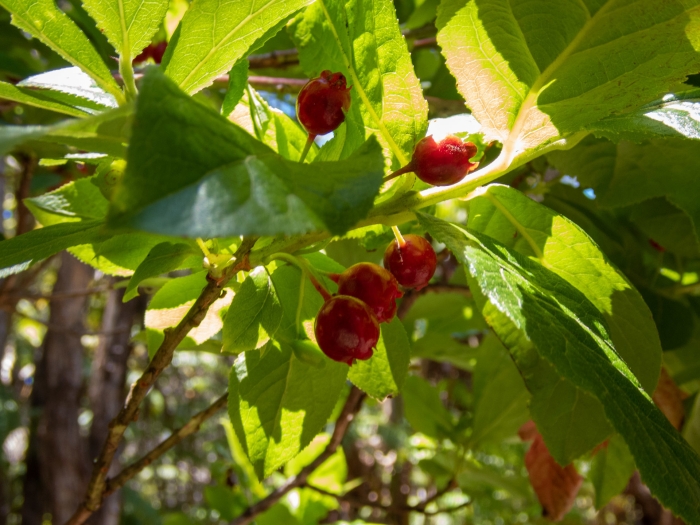ʻōhelo Kau Lāʻau
(Vaccinium calycinum)
ʻōhelo Kau Lāʻau (Vaccinium calycinum)
/
/

Will Sides
CC BY 4.0
Image By:
Will Sides
Recorded By:
Copyright:
CC BY 4.0
Copyright Notice:
Photo by: Will Sides | License Type: CC BY 4.0 | License URL: http://creativecommons.org/licenses/by/4.0/ | Rights Holder: Will Sides | Publisher: iNaturalist | Date Created: 2021-06-06T11:18:28-07:00 |
























Estimated Native Range
Summary
Vaccinium calycinum, commonly known as ʻŌhelo kau lāʻau, is a small evergreen shrub native to the understory of montane rainforests and subalpine shrublands in Hawaii, particularly on the islands of Kauaʻi, Oʻahu, Molokaʻi, Maui, and Hawaiʻi. It typically grows to a height of 1-3 feet (0.3-0.9 meters) with a similar spread. The plant features small, leathery leaves and bears small, white to pinkish, urn-shaped flowers that are subtly showy, followed by the notable edible red berries, which resemble cranberries in appearance and taste.
ʻŌhelo kau lāʻau is valued for its edible berries, which are used in local Hawaiian cuisine and are also an important food source for native birds. The plant is cultivated for its cultural significance and for wildlife gardens, where it supports local biodiversity. It thrives in well-drained volcanic soils, preferring partial shade but can also tolerate full sun in cooler, higher elevation habitats. While it is relatively low-maintenance, it does require consistent moisture and benefits from the application of an acidic fertilizer. It is not commonly affected by diseases but can be susceptible to root rot if overwatered or planted in poorly drained soils. This shrub is not known for being invasive and is considered a valuable addition to native plant gardens and restoration projects in Hawaii.CC BY-SA 4.0
ʻŌhelo kau lāʻau is valued for its edible berries, which are used in local Hawaiian cuisine and are also an important food source for native birds. The plant is cultivated for its cultural significance and for wildlife gardens, where it supports local biodiversity. It thrives in well-drained volcanic soils, preferring partial shade but can also tolerate full sun in cooler, higher elevation habitats. While it is relatively low-maintenance, it does require consistent moisture and benefits from the application of an acidic fertilizer. It is not commonly affected by diseases but can be susceptible to root rot if overwatered or planted in poorly drained soils. This shrub is not known for being invasive and is considered a valuable addition to native plant gardens and restoration projects in Hawaii.CC BY-SA 4.0
Plant Description
- Plant Type: Shrub
- Height: 1-6 feet
- Width: 1-3 feet
- Growth Rate: Moderate
- Flower Color: Green, Red, Yellow
- Flowering Season: Spring, Summer, Fall, Winter
- Leaf Retention: Evergreen
Growth Requirements
- Sun: Part Shade, Full Sun
- Water: Medium
- Drainage: Medium
Common Uses
Bird Garden, Edible*Disclaimer: Easyscape's listed plant edibility is for informational use. Always verify the safety and proper identification of any plant before consumption., Groundcover, Low Maintenance
Natural Habitat
Native to the understory of montane rainforests and subalpine shrublands in Hawaii
Other Names
Common Names: Ohelo, Hawaiian Blueberry, Ohelo Berry
Scientific Names: , Vaccinium calycinum, Metagonia calycina, Vaccinium berberifolium, Vaccinium calycinum f. fauriei, Vaccinium calycinum f. fimbriatum, Vaccinium calycinum f. hamatidens, Vaccinium calycinum f. meyenianum, Vaccinium calycinum subsp. fauriei, Vaccinium calycinum subsp. fimbriatum
GBIF Accepted Name: